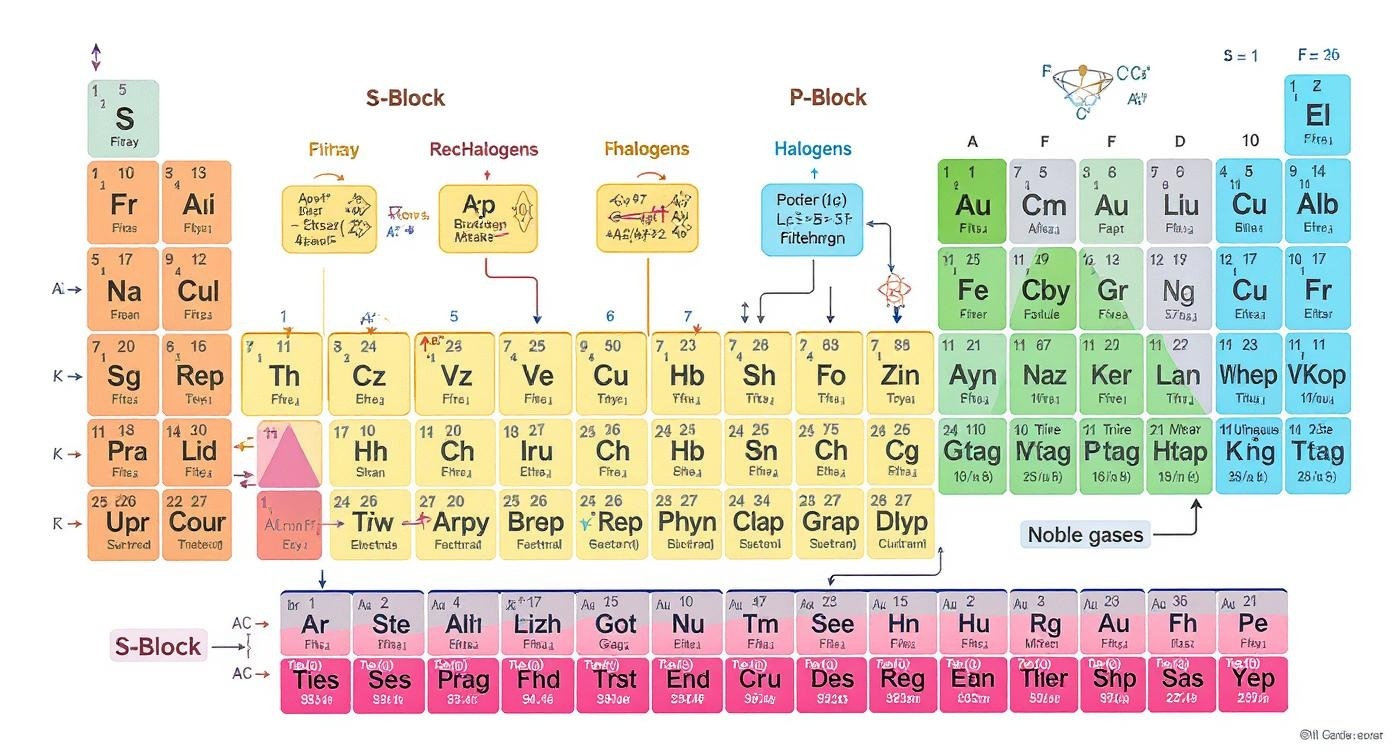S-Block & P-Block Elements
Complete Study Guide for Nursing Students
Welcome to Advanced Chemistry
Understanding S-Block and P-Block elements is crucial for nursing practice. These elements form the foundation of many medications, biological processes, and clinical interventions you’ll encounter in your career. This comprehensive guide will help you master the concepts of electronegativity, electron configurations, and clinical applications.
Learning Tip: Focus on how these elements’ properties directly relate to their clinical uses and biological functions.
Table of Contents
Visual Overview

Interactive periodic table showing S-Block and P-Block elements with electronegativity trends
S-Block Elements
Groups 1 & 2: The Foundation of Ionic Chemistry
Fundamental Properties
Electron Configuration
S-block elements have their outermost electrons in s orbitals. This configuration directly affects their electronegativity values, making them highly reactive metals that readily lose electrons.
General Pattern:
- Group 1: [Noble gas] ns¹
- Group 2: [Noble gas] ns²
Key Characteristics
Alkali Metals (Group 1)
Memory Aid – “LINKLR”
Lithium, Natrium, Kalium, Rbidium, Csesium, Francium
“Lions Never Keep Running, Cats Follow”
| Element | Symbol | Electronegativity | Clinical Use |
|---|---|---|---|
| Lithium | Li | 0.98 | Bipolar disorder treatment |
| Sodium | Na | 0.93 | Electrolyte balance, IV fluids |
| Potassium | K | 0.82 | Cardiac function, muscle contraction |
Clinical Insight
The low electronegativity of alkali metals makes them excellent for creating ionic compounds that dissociate easily in body fluids, which is why sodium and potassium are essential electrolytes.
Alkaline Earth Metals (Group 2)
Memory Aid – “Be Mg Ca Sr Ba Ra”
“Betty Mgives Candy, Sreally Bad Rabbits”
Properties
- Higher electronegativity than Group 1
- Form +2 ionic charges
- Less reactive than alkali metals
- Higher melting points
Clinical Significance
- Calcium: Bone health, muscle function
- Magnesium: Enzyme cofactor, cardiac rhythm
- Barium: Contrast agent in imaging
Electronegativity Trend
As we move down Group 2, electronegativity decreases: Be (1.57) > Mg (1.31) > Ca (1.00) > Sr (0.95) > Ba (0.89)
P-Block Elements
Groups 13-18: Diverse Chemistry and Biological Functions
Fundamental Characteristics
Electron Configuration
Outermost electrons in p orbitals (ns² np¹⁻⁶)
Bonding Variety
Covalent, ionic, and metallic bonding types
Electronegativity Range
Wide range from metals to highly electronegative nonmetals
P-Block Groups Overview
| Group | Name | Key Elements | Clinical Relevance |
|---|---|---|---|
| 13 | Boron Group | B, Al, Ga | Aluminum antacids, boron supplements |
| 14 | Carbon Group | C, Si, Sn, Pb | Organic compounds, lead poisoning |
| 15 | Nitrogen Group | N, P, As | Proteins, DNA, phosphates |
| 16 | Oxygen Group | O, S, Se | Respiration, amino acids |
| 17 | Halogens | F, Cl, Br, I | Disinfectants, thyroid function |
| 18 | Noble Gases | He, Ne, Ar, Kr, Xe | Anesthesia, inert environments |
Halogens (Group 17) – The Sanitizers
Memory Aid – “F Cl Br I At”
“Four Clever Brothers Invented Atoms”
Properties
- Highest electronegativity in periods
- Form -1 ionic charges
- Seven valence electrons
- Highly reactive nonmetals
Clinical Applications
- Fluorine: Dental health, bone strength
- Chlorine: Water purification, antiseptics
- Bromine: Sedatives (historical)
- Iodine: Thyroid function, antiseptic
Safety Note
Halogens are highly reactive due to their high electronegativity. Always handle halogen-containing compounds with proper precautions in clinical settings.
Noble Gases (Group 18) – The Inert Champions
Unique Properties
Medical Applications
- Helium: Breathing gas mixtures
- Neon: Indicator lights in equipment
- Argon: Laser surgery
- Xenon: Anesthetic agent
Clinical Insight
The chemical inertness of noble gases makes them ideal for medical applications where reactive substances could cause complications. Their low electronegativity contributes to their stability.
Clinical Applications
Real-world applications in nursing practice
Electrolyte Management
Key S-Block Electrolytes
Sodium (Na⁺)
Normal range: 136-145 mEq/L
Essential for fluid balance and nerve transmission. Low electronegativity enables easy ionization.
Potassium (K⁺)
Normal range: 3.5-5.0 mEq/L
Critical for cardiac rhythm and muscle function. Monitor closely with certain medications.
Monitoring Guidelines
- Regular lab monitoring in ICU patients
- Check before diuretic administration
- Continuous cardiac monitoring for abnormal levels
- Trend analysis for early intervention
Antiseptics and Disinfectants
| Element | Compound | Use | Mechanism |
|---|---|---|---|
| Chlorine | Sodium hypochlorite | Surface disinfection | Oxidizes cell components |
| Iodine | Povidone-iodine | Skin antiseptic | Penetrates cell wall |
The high electronegativity of halogens makes them excellent oxidizing agents, which is the basis of their antimicrobial action.
Practice Questions
Test your understanding
Quick Review
1. Which group has the lowest electronegativity?
Answer: Group 1 (Alkali metals) – they readily give up electrons
2. Why is iodine important for thyroid function?
Answer: Iodine is essential for thyroid hormone synthesis (T3 and T4)
Clinical Scenarios
Scenario: Patient with hypokalemia
Consider: K⁺ replacement, cardiac monitoring, medication interactions
Scenario: Preparing for surgery
Consider: Iodine-based antiseptics, patient allergies, proper application
Global Best Practices
International standards and innovations
International Guidelines
WHO Recommendations
- Universal salt iodization programs
- Fluoride supplementation guidelines
- Hand hygiene with chlorhexidine
Innovation Examples
- Japan: Advanced electrolyte monitoring systems
- Netherlands: Precision dosing of lithium therapy
- Australia: Novel halogen-based antiseptics
Key Insight: Understanding electronegativity patterns helps nurses worldwide apply evidence-based practices for medication administration and infection control.
Key Takeaways
S-Block Elements
- • Low electronegativity makes them excellent electrolytes
- • Essential for cardiac and muscle function
- • Require careful monitoring in clinical settings
P-Block Elements
- • High electronegativity in halogens enables antimicrobial action
- • Noble gases provide inert environments for procedures
- • Essential for biological processes and medical applications
Master these concepts to excel in nursing chemistry and provide exceptional patient care!
